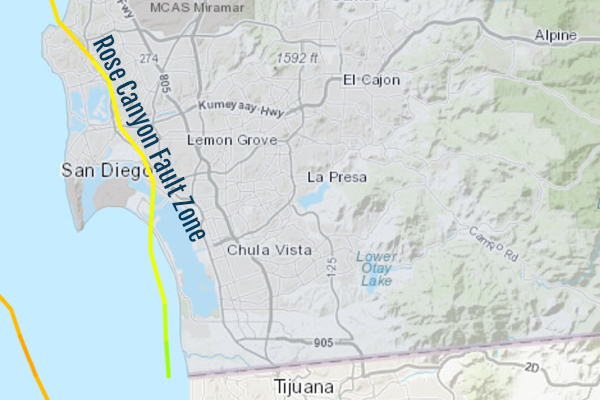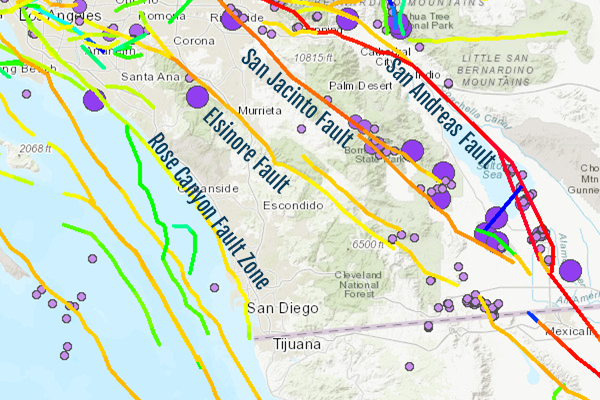What is the Risk of a San Diego Earthquake?
The San Andreas network of faults can cause powerful earthquakes—as big as magnitude 8—that can generate strong shaking levels in San Diego. There is 75% probability of one or more magnitude 7.0 or greater earthquakes striking Southern California, based on a 30-year period, beginning in 2014.
San Diego's multiple fault lines and & earthquake prediction
In addition to the San Andreas, San Diego earthquake risk centers on three active quake faults:
- The Rose Canyon fault, an extension of the Los Angeles Newport-Inglewood fault, which runs along the coast and beneath downtown San Diego. In a recent report, earthquake geologists and engineers say this fault is the biggest earthquake threat to San Diego, capable of earthquakes of magnitude 6.5 to 6.8.
- The Elsinore and San Jacinto faults, which cut through East County and can also generate moderately-sized but damaging earthquakes.
See Your Local Earthquake Risk
Predicting San Diego Earthquakes: Assessing the Risks and Consequences
The earthquake risks in San Diego could disrupt the easy beach going life we have come to enjoy.
After a major earthquake, the recent EERI San Diego Earthquake Scenario study predicted that the region would experience $5.2 billion lost income, and 36,000 households would be displaced. Water, sewer lines and gas line services could be out for months. The I-5 transportation corridor as well as airport and rail services would be seriously affected by the rupture.
Other San Diego Earthquake effects include:
- Widespread liquefaction along Mission Bay, Mission Valley, the San Diego International Airport, Coronado island and the South Bay cities of Chula Vista, National City and Imperial Beach.
- Liquefaction on the nation’s fourth biggest Department of Defense facilities, home to three nuclear aircraft carriers.
- Earthquake-triggered landslides on the hills of San Diego would affect Mount Soledad, Point Loma, Mission Valley, and Sorrento Valley.
Effects & damage of a major earthquake in San Diego
Five million people live in the greater San Diego cross-border community. San Diego’s large population and poor seismic resistance of its older buildings and infrastructure systems make San Diego very vulnerable to earthquakes.
- 45% of residential building would be damaged.
- 23,000 residential units would suffer severe or completed damage.
- 36,000 households would be displaced.
- Major San Diego earthquakes would ruin the area’s aging apartments and houses, adding to the crisis in affordable housing.
California earthquake insurance can protect against damages to your home and belongings.
San Diego earthquake risk map with fault lines
People who study earthquakes say the San Diego Rose Canyon fault could cause a 6.9 magnitude quake and threaten the safety of thousands. The Rose Canyon fault line starts near Mission Valley and heads north toward La Jolla where it joins other faults.
Most San Diegans live near an active earthquake fault. Find out about your home’s San Diego earthquake risk with CEA’s earthquake fault map by county.
Notable faults in San Diego
San Diego, Los Angeles and Big Sur are on the Pacific Plate of the San Andreas fault. San Francisco, Sacramento and the Sierra Nevada are on the North American Plate. This sliding boundary between the plates is what causes major earthquakes.
San Diego has three active faults. The Rose Canyon fault, a strike-slip fault running in a north-south direction through San Diego County, poses the biggest risk of an earthquake.
The Rose Canyon Fault
The Rose Canyon fault poses the biggest earthquake risk. It could bring devastation to San Diego and its Mexican sister cities. It is a right-lateral fault that runs in a north-south direction through the county before resting beneath the City of San Diego.
Neighborhoods affected by a big quake include: Mission Bay, Mission Valley, Coronado island, Chula Vista, National City, Imperial Beach, Mount Soledad, Point Loma, and Sorrento Valley. The San Diego International Airport and Department of Defense facilities would also sustain damage.
The Elsinore Fault
Elsinore fault extends for approximately 180 km through Southern California. Despite its size, it is one of the quietest faults in the region, often called the sleeping giant.
The San Jacinto Fault
San Jacinto fault is a strand of the strike-strip zone of the Southern San Andreas fault. Scientists consider the San Jacinto fault to be one of the most seismically active faults in the SoCal area. It runs through San Bernardino, Riverside, San Diego, and Imperial Counties.
how to mitigate earthquake damage - San Diego earthquake preparedness
The shaking from a major San Diego earthquake can move almost everything inside your home.
Prepare for next earthquake, by evaluating the safety of your home. Then assemble your earthquake safety kit and gather essential supplies. Keep your family safe and prevent the injury of your loved ones by being prepared. Don’t forget financial protection against earthquake damage with budget-friendly CEA earthquake insurance.
Learn more about San Diego risk and how to prevent loss from an earthquake:
Know What to do During an Earthquake
An earthquake is a sudden, rapid shaking of the earth caused by the shifting of rock beneath the earth’s surface. Earthquakes strike without warning, at any time of year, day or night.
Prepare now for your family’s safety and recovery from a devastating San Diego earthquake. Create an earthquake safety plan. Practice Drop, Cover, and Hold On.
Learn about earthquake survival tips to keep your family prepared before the next big one hits.
Understand Geologic & Structural Risks to Your House
Whether it is the sleeping giant Elsinore fault, San Jacinto fault or Rose Canyon, earthquake fault activity will cause great devastation for the San Diego community.
Understand the potential geologic threats to your home in case of a major earthquake by learning your San Diego earthquake risk.
The violent shaking from earthquakes can rupture the earth, trigger landslides and turn the surface of the earth to liquid. Your home also may be vulnerable to serious structural damage if it was built before 1980.
Purchase Affordable Coverage
Most people in San Diego live 15 miles from a fault. Be prepared. CEA affordable and flexible home earthquake policies:
- Offer choices of coverage and deductibles.
- Protect the investment in your home and valuables.
- Provide homeowner premium discounts if you retrofit your home or mobile home.
- Give you peace of mind when, not if, a major San Diego earthquake hits.
Typical home insurance policies and tenant insurance don’t include earthquake coverage. California homeowners or renters need a separate earthquake policy to cover damages from an earthquake. Discover a policy that fits your risk with an estimate.
Is Earthquake Insurance Worth it in San Diego?
San Diego earthquakes can strike at any time or at any place. Think through what you would do in the event of a large earthquake:
- Without residential earthquake insurance can you afford all repair, replacement and/or rebuilding costs to your home and belongings?
- Wait for government disaster assistance? If available, FEMA’s help only comes in the form of a small grant or capped loan, which may cover only a portion of your repair costs.
- Where would you live if your home was made uninhabitable because of earthquake damage? Without Loss of Use earthquake coverage—which includes covering additional expenses of living elsewhere if you have to move out of your home because of earthquake damage—you’d still be paying your mortgage plus temporary housing rent during the time repairs are underway.
Earthquake insurance in San Diego is available to meet your needs. CEA affordable earthquake insurance policies let you select the coverage that fits your budget.
How much is earthquake insurance in San Diego?
San Diego earthquake insurance premiums depend on the amount of coverage you choose, the location of your home, your home’s structure, and the amount of deductible you select. Average annual costs are:
|
|
$100–$444The annual cost for a CEA earthquake insurance policy for a typical house in San Diego (single-story, wood-framed, built on a slab foundation in 1962, with a reconstruction cost of about $353,000). |
|
|
$35–$304The annual cost for a CEA earthquake insurance policy for renters in San Diego. |
|
|
$45-$121The annual cost for a CEA earthquake insurance policy for a mobilehome in San Diego (built in 1980 with a reconstruction cost of $100,000). |
|
|
$35–$696The annual cost for a CEA earthquake insurance policy for a condo unit in San Diego (with a fair market value of more than $135,000). |
Without earthquake insurance, you will have to pay from savings to repair and replace earthquake damage to your home and valuables, and cover needed temporary housing.
Find a policy today with a free estimate.
Get an earthquake insurance estimate!
San Diego is earthquake country with three active faults that could affect the safety and property of thousands of people.
Without CEA’s affordable earthquake home insurance, you will be responsible for the cost to repair your home and replace your belongings after a major San Diego earthquake.
No need to wait until your home policy renewal. Select from 5%-25% deductibles. Find out if earthquake insurance in San Diego is right for you with an estimate now.
GET YOUR EARTHQUAKE INSURANCE ESTIMATE
Sources used:
- EERI San Diego Earthquake Scenario
- Earthquake Alliance San Diego
- Southern California Earthquake Center
- San Diego Union Tribune
- Los Angeles Times: San Diego Faces Critical Earthquake Danger






